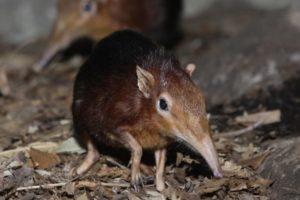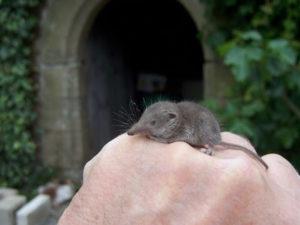Common shrew: when the reputation is not deserved
Gardeners and summer residents face many small animals on their plots, which cause them serious inconvenience. However, some species of such animals received the status of "pests" completely undeservedly. These primarily include the shrew.
Content
What does a shrew look like: photo
Name: Shrews
Latin: sorexClass: Mammals - Mammalia
Squad: Insectivores - Eulipotyphla or Lipotyphla
Family: Shrews - Soricidae
 | Habitats: | shaded areas of forests and steppes |
 | What does it eat: | small insects, bugs |
 | Description: | predatory mammals that do more good than harm |
Animal description
The common shrew is a member of the shrew family, which is very widespread in many countries. She is the largest member of the family.
Appearance of the animal
The shrew looks very much like representatives of the mouse family, but has an oblong muzzle that looks like a proboscis. The body length of an adult animal is 5-8 cm. The tail can be 6-7,5 cm long.
Sometimes it is covered with sparse hairs. The weight of a mammal is from 4 to 16 grams.
The fur of the animal on the back is painted in dark brown, almost black. On the belly, the fur is light brown, sometimes dirty white. The color of young individuals has a lighter shade. The auricles are small and densely covered with fur.
shrew lifestyle
What does the shrew eat
These small mammals are predators. They spend most of their time looking for food. The constant feeling of hunger in the animal is due to a very fast metabolism.
In summer time The main food for shrews are:
- larvae;
- earthworms;
- insect pupae;
- butterflies;
- dragonflies;
- mouse rodents.
In winter, the diet of the animal consists of insects wintering in the upper layers of the soil. Once in pantries and cellars, the animal does not spoil food stocks, but only looks for hibernating insects.
These mammals rarely eat plant foods. Only in the cold season can shrews supplement their meager diet with nuts or seeds from spruce and pine cones.
shrew breeding
The female shrew brings offspring 2-3 times a year. In one offspring, 7-8 cubs usually appear. The duration of pregnancy of the animal is 18-28 days. Animals are born blind and naked, but already 30 days after birth they are able to independently find their own food. The average lifespan of a shrew is 18 months.
Reproduction of shrews occurs only in the warm season. Before giving birth, the female prepares a nest, which is covered with moss or dry grass. As a place for arranging a nest, animals choose old stumps, abandoned burrows or convenient depressions in the upper layers of the soil.
some species
Shrews are a whole subfamily. There are more than 70 species of them. There are some of the most common:
- ordinary or forest, an animal common in thickets;
- tiny or Chersky, the smallest representative up to 4 grams;
- Tibetan, similar to ordinary, but living in mountainous areas;
- Bukhara, an alpine animal of light brown color with a brush on the tail;
- medium, a variety with a white tummy, lives mainly on the islands;
- giant, one of the rare representatives of the Red Book;
- small, baby shrew, brown-gray with stuffed fur.
shrew habitat
The habitat of the shrew includes almost the entire territory of Eurasia. The animal especially prefers shady and damp areas. It can be found in meadows, forests and parks.
Shrews settle near people only in winter. They find shelter for themselves in cellars and pantries.
In the hungriest year, they can pick up a dwelling.
If a shrew gets into a place where people store supplies, it will look for bugs and larvae.
Fast, nimble, predator. Prefers not to run into people.
What harm does a shrew cause to a person
The shrew is an almost harmless animal. Since the diet of a mammal consists mainly of insects, they do more good than harm. They eat a huge number of pests that cause serious damage to plants.
Conclusion
Quite often, shrews are confused with representatives of the mouse family and all their sins are attributed to them. However, these animals are not at all malicious pests and, on the contrary, help protect the crop from dangerous insects. Therefore, before trying to expel shrews from the site, it is better to think about whether it is worth doing.
Previous
